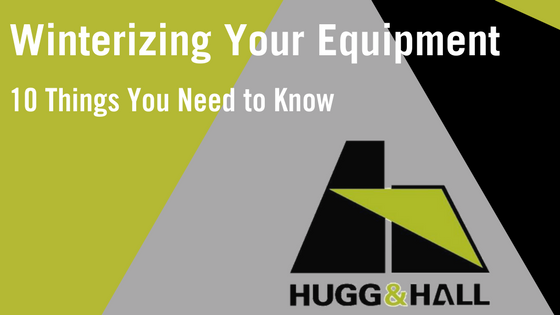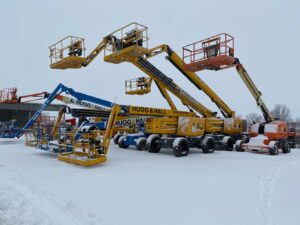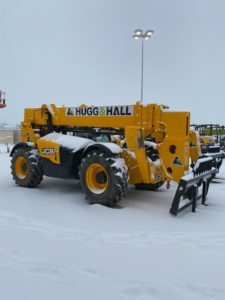
10 Quick Ways to Winterize Your Equipment
Even people who love winter don’t love its impact on construction sites. Snow and freezing temps can cause huge delays and damage your equipment. We’ve got ten quick and easy tips for winterizing equipment so you can start enjoying the snow again!
Want more information on how to keep your jobsite safe during winter weather? Download our complete guide to winter construction site prep!
1. Use weather-appropriate oil and coolant
It’s a good idea to switch to a low-viscosity oil before winter. They are thinner and flow faster than a high-viscosity oil. In cold temps, low-viscosity oils provide better startup protection for your equipment. The faster your oil reaches your engine components, the less wear on the engine.
Your coolant ratios can also affect your engine negatively in the winter. Typically, the recommended ratio of coolant to water is 50/50, but this ratio is more likely to freeze because of the high water content. A 70/30 ratio can help prevent freezing.
Check out this coolant article if you have additional questions about winter coolant levels.
2. Clean your equipment prior to storing
Dirt, mud, snow, and other contaminants can harden on equipment. Cleaning helps keep your equipment in good shape. Pay special attention to the engine bay, undercarriage, wheel hubs, breaks, and exposed areas. These are vulnerable to damage.
3. Properly maintain and store batteries for the colder months
If you’re using your equipment during winter, verify that the battery electrolyte is filled to the indicated level. Clean the terminal of the battery to prevent it from slowly draining. Never charge a frozen battery, as this may cause it to explode.
If you’re not using your equipment, remove the battery and store it in a clean, dry area. Leave it connected to a battery maintainer to ensure it stays charged.
4. Protect your tires
Lower temperatures reduce tire pressure. Always check the pressure and inspect tires for wear and tear. If possible, consider using track-mounted equipment in the colder months.
5. Store your equipment
Reducing moisture is one of the top priorities when you’ve chosen to store your equipment. Your storage site should be enclosed with a concrete floor, not a dirt floor, to reduce moisture. Keep the windows of any vehicle cabins cracked to allow air to circulate. This helps reduce mold and moisture buildup in the cabin. You can take rodent-resistance measures by adding a ball of steel wool in the exhaust pipe and air intake openings and placing mothballs inside cabins. Always check that all pest deterrents are removed before operation.
6. Maintain your fuel tank
Maintaining the fuel tank prevents condensation inside the tank and fuel lines. Fuel treatments thaw frozen fuel filters, liquefy fuel, and remove moisture from the tank and lines. Keep a spare filter available for your convenience.
7. Remember to grease
Maintain all grease points, even if your equipment isn’t in use. Moisture is your enemy in the winter, and greasing prevents moisture buildup and damage to your equipment. Manufacturers recommend using low-temperature lubricants during the colder months.
8. Check fluids
Regularly check fluid levels and top off when necessary. If your engine oil is thick or sooty, change the oil before storing or using it in winter. Antifreeze levels are particularly important to check regularly.
9. Conduct routine maintenance, even if the vehicle won’t be used
Take advantage of the off-season to address any maintenance issues and examine equipment for potential issues. Preventative maintenance can help prevent downtime during the busier months.
10. Monitor diesel exhaust fluid for freezing
If your equipment is using Diesel Exhaust Fluid (DEF), make sure you have a way to heat and thaw it. DEF will freeze at 10 degrees Fahrenheit or lower.

If you or your company need any additional resources, Hugg & Hall is here to help! Contact our service department if you have any questions about winterizing equipment.
Interested in learning more about keeping your team safe and your equipment in tip-top shape? Download our complete Winter Prep Guide!
Want more winter weather tips and tricks? Check out our resources section!
Editor’s Note: This post was originally published in November 2017 and was updated for freshness, accuracy, and comprehensiveness in December 2022.
Back to News
Subscribe and unlock cutting-edge equipment insights, trends and tips!
Subscribe
